MY GREAT UNCLE: GEORGE RAY…
(20th November 1893-April 1970)
So, George was my paternal grandfather’s younger brother and he, like so many others who were born in the late 1800s, went to war in 1914. He was 21 years old then and had been married on Boxing Day 1917 to Ellen Cope, also known as Nellie, from 22 Rowland Street, Birmingham. The wedding took place at the St James the Less Church, Ashted.
 |
| ST JAMES THE LESS... |
George survived the trauma of war to return to Birmingham, where he was living in 1939 at 28 Audley Road Stechford, right opposite the first school I taught at. He was described as a steel polisher, not so different from his brother, my grandfather, who was a bicycle handlebar polisher…
His children then were George, 20; Martin Peter, 18 and Agnes E, 16…
Ellen his wife was born in Aston, the daughter of an iron stamper and then gas worker/stoker, Joseph Cope from 6 Wharton Street, who had been born in Birches Green. Joseph’s wife was Elizabeth (Dugmore) from 38 Argyle Street, whose father had been a corkscrew maker, of all things.
Ellen was also a polisher and living in Adams Street before she married George, who then moved in with her after World War One.
 |
| ADAMS STREET... |
I recall my dad collecting insurance from a family member in Audley Road in Stechford so it would likely have been someone related to George. He was then living only just round the corner from his nephew Bill, my dad’s brother, who resided at 79 Church Lane. I met the lady who paid insurance to my dad but I recall little of those meetings and I don’t yet know who she was…
When George’s parents Joseph and Ann were living in Holt Street in 1901, George was an 8 year old scholar, then in 1911 he was listed as a lodger at 18 Back of 39 Clarenden Street, by then a cycle polisher, unsurprisingly, with the Wooldridge family. Laura Wooldridge was a 45 year old widow and head of the household but surely George was working with my grandfather as a cycle polisher?
World War I…
His address when he joined up was written as 6 Back of 147 Devon Street and his army number was 83767. He was a gunner in the Royal Field Artillery and sent to train at Hilsea. He was 5 feet 3 and a half inches tall, 131 pounds in weight, with grey eyes and I think brown hair, although the hand written information is faint on that point, but he had defects to his teeth, apparently!
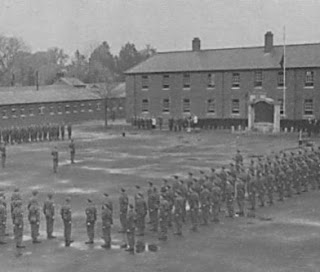 |
| HILSEA BARRACKS... |
He trained in Aldershot too and was in trouble for overstaying ‘special leave’ on 15th April 1915, being absent between midnight and 3pm the following day. He was punished by being confined to barracks for 7 days and the officer who instigated this was a Sergeant Draper.
He was with ‘B' Battery, 47th Brigade, 14th Division of the British Expeditionary Force but there is some fascinating correspondence from Ellen (Nellie) who wrote to the war office asking about the whereabouts of George during the war but she called herself Miss Nellie Ray, thus wanting to be considered his sister and therefore entitled to receive official information…
 |
| ELLEN'S LETTER (SIGNED 'NELLIE'...) |
 |
| TOUGH GOING FOR THE RFA (ROYAL FIELD ARTILLERY)... |
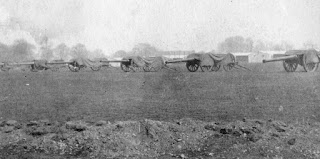 |
| BLACK & WHITE ADDS A GRIMNESS TO THESE IMAGES... |
George also wrote a letter after the war was over, in reference to the Somme on 16th September 1916, for he was expecting a Military Medal for his bravery in keeping the communications working between his battery and an observation post. He was described then as a signaller and this was tough work, for it is unlikely that in battle conditions he would be using semaphore flags… He was probably having to check and repair wiring to keep communications live by venturing out of his position under fire. He was wounded there too from a gunshot to the knee and he received medical treatment at a Red Cross Hospital in Étaples, although an official form cites a ‘severe hip’ injury, rather than a knee wound…
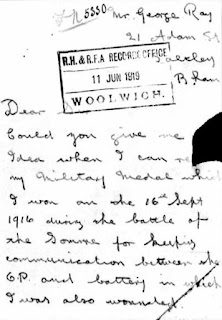 |
| GEORGE'S LETTER... |

ONE OF THE CLEARING STATIONS...
He was certainly returned to England aboard the Hospital Ship Cambria and he was treated at the East Leeds War Hospital between 27th September and 7th November, 1916. Later that year on 1st December he was listed as being a Gunner in the 50th Reserve Battery of the Royal Field Artillery at Charlton Park, near Malmesbury, a town I have visited to watch a football match in recent years…
 |
| HS CAMBRIA... |
 |
| EAST LEEDS AGAIN... |
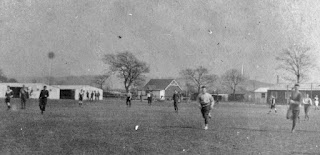 |
| CHARLTON PARK... |
He was gazetted (mentioned in a newspaper) and finally received his Military Medal for ‘gallantry and devotion to duty under fire’ following the Great War, which he and his family must have been really proud of. He also received the 1914-15 Star on 24th September 1920, which was awarded to soldiers fighting in any theatre against the Central European Powers…
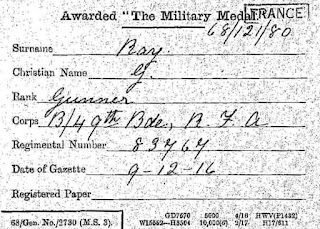 |
| FOR THE MILITARY MEDAL (BELOW...) |

FOR THE STAR MEDAL... 
THE STAR, AS AWARDED TO ANOTHER SOLDIER...
The Military Cross arena:
George took part in the Battle of Flers-Courcelette from 15th September and it appears that on 16th September 1916, 1,000 yards of ground was taken by the Allies, Danube Trench was taken and Mouquet Farm was captured, near Thiepval… (You could almost assume that the British soldiers named the town Corselette and the farm Moo-cow Farm…)
 |
| FIGHTING AT MOUQUET FARM... |
 |
| THE FARM BEFORE THE BATTLE... |
Tanks were used in this advance for the first time, so George would have seen them in action…
 |
| THE TANK MAKES ITS DEBUT... |
 |
| RFA AT FLESQUIÈRES... |
Audley Road:
In the electoral roll of 1945, 28 Audley Road, as far as I can tell saw a George Ray and Agnes Ray living there, presumably either my great uncle, or his son, also a George of course and his daughter… However, in 1955 living at the house was an Ellen E Ray, plus a Cyril Moss, Ellen Moss and Alma Musa…
This house needs investigating to find out exactly who was living there in the 1970s, so that I can identify who had insurance with my dad’s company and who I spoke to maybe a couple of times!
 |
| A TYPICAL RFA SIGNALLER... |










No comments:
Post a Comment